fuel cap CHEVROLET CAMARO 1998 4.G Owners Manual
[x] Cancel search | Manufacturer: CHEVROLET, Model Year: 1998, Model line: CAMARO, Model: CHEVROLET CAMARO 1998 4.GPages: 402, PDF Size: 21.2 MB
Page 150 of 402
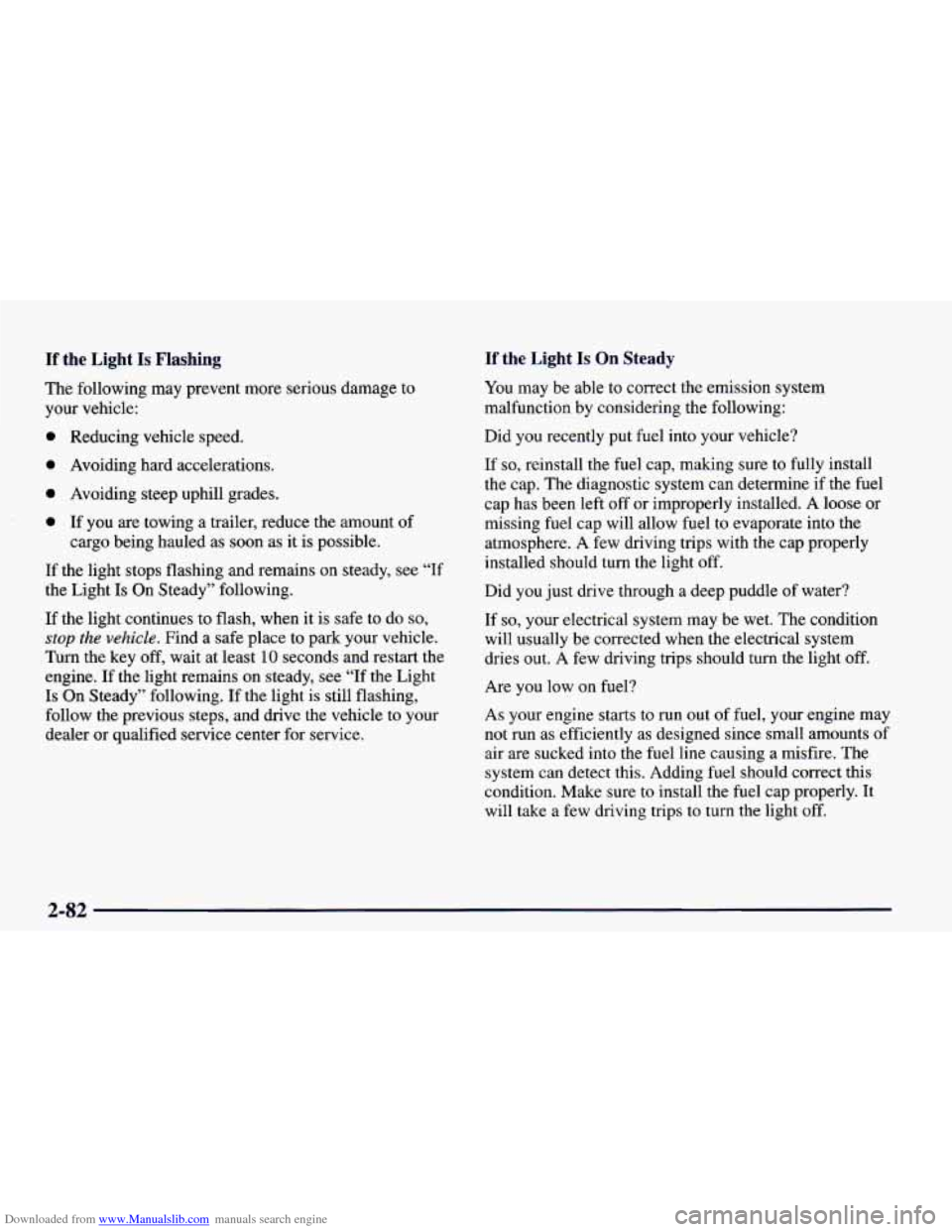
Downloaded from www.Manualslib.com manuals search engine If the Light Is Flashing
The following may prevent more serious damage to
your vehicle:
0 Reducing vehicle speed.
0 Avoiding hard accelerations.
0 Avoiding steep uphill grades.
0 If you are towing a trailer, reduce the amount of-
cargo being hauled as soon as it is possible.
If the light stops flashing and remains
on steady, see “If
the Light Is
On Steady” following.
If the light continues to flash, when it is safe to do
so,
stop the vehicle. Find a safe place to park your vehicle.
Turn the key
off, wait at least 10 seconds and restart the
engine.
If the light remains on steady, see “If the Light
Is On Steady” following. If the light is still flashing,
follow the previous steps, and drive the vehicle to your
dealer or qualified service center for service.
If the Light Is On Steady
You may be able to correct the emission system
malfunction by considering the following:
Did you recently put fuel into your vehicle?
If
so, reinstall the fuel cap, making sure to fully install
the cap. The diagnostic system can determine if the fuel
cap has been left off or improperly installed.
A loose or
missing fuel cap will allow fuel to evaporate into the
atmosphere.
A few driving trips with the cap properly
installed should turn the light off.
Did you just drive through a deep puddle of water?
If
so, your electrical system may be wet. The condition
will usually be corrected when the electrical system
dries out.
A few driving trips should turn the light off.
Are you low on fuel?
As your engine starts to run out of fuel, your engine may
not run as efficiently as designed since small amounts of
air are sucked into the fuel line causing a misfire. The
system can detect this. Adding fuel should correct this
condition. Make sure to install the fuel cap properly.
It
will take a few driving trips to turn the light off.
2-82
Page 153 of 402
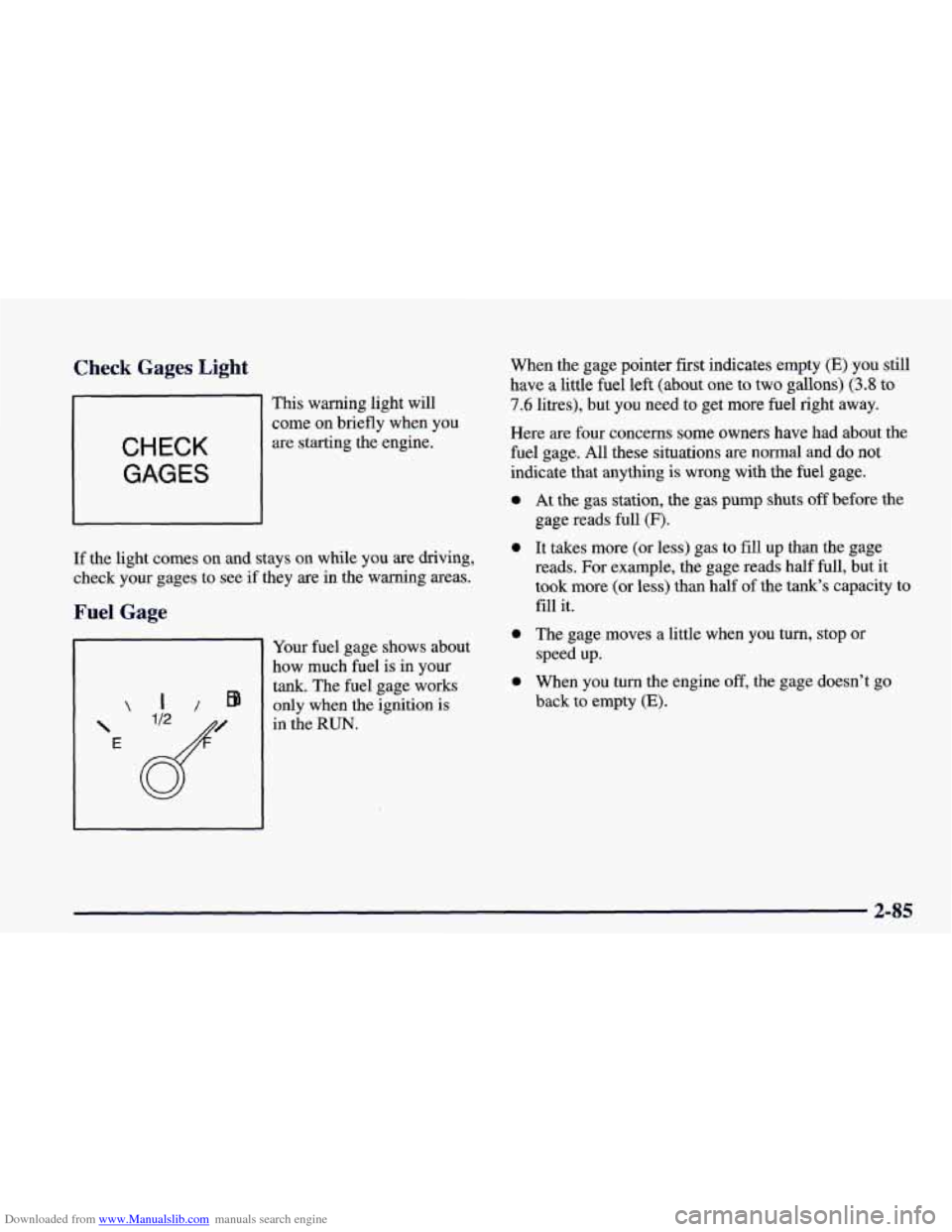
Downloaded from www.Manualslib.com manuals search engine Check Gages Light
CHECK
GAGES
This warning light will
come on briefly when you
are starting the engine.
If the light comes on and stays on while you are driving,
check your gages to see if they are in the warning areas.
Fuel Gage
Your fuel gage shows about
how much fuel is in your
tank. The fuel gage works
only when the ignition is
in the
RUN.
When the gage pointer first indicates empty (E) you still
have a little fuel left (about one to two gallons)
(3.8 to
7.6 litres), but you need to get more fuel right away.
Here are four concerns some owners have had about the
fuel gage. All these situations are normal and do not
indicate that anything
is wrong with the fuel gage.
0 At the gas station, the gas pump shuts off before the
gage reads full
(F).
0 It takes more (or less) gas to fill up than the gage
reads. For example, the gage reads half full, but it
took more (or less) than half of the tank’s capacity to
fill it.
0 The gage moves a little when you turn, stop or
speed up.
0 When you turn the engine off, the gage doesn’t go
back to empty (E).
2-85
Page 157 of 402
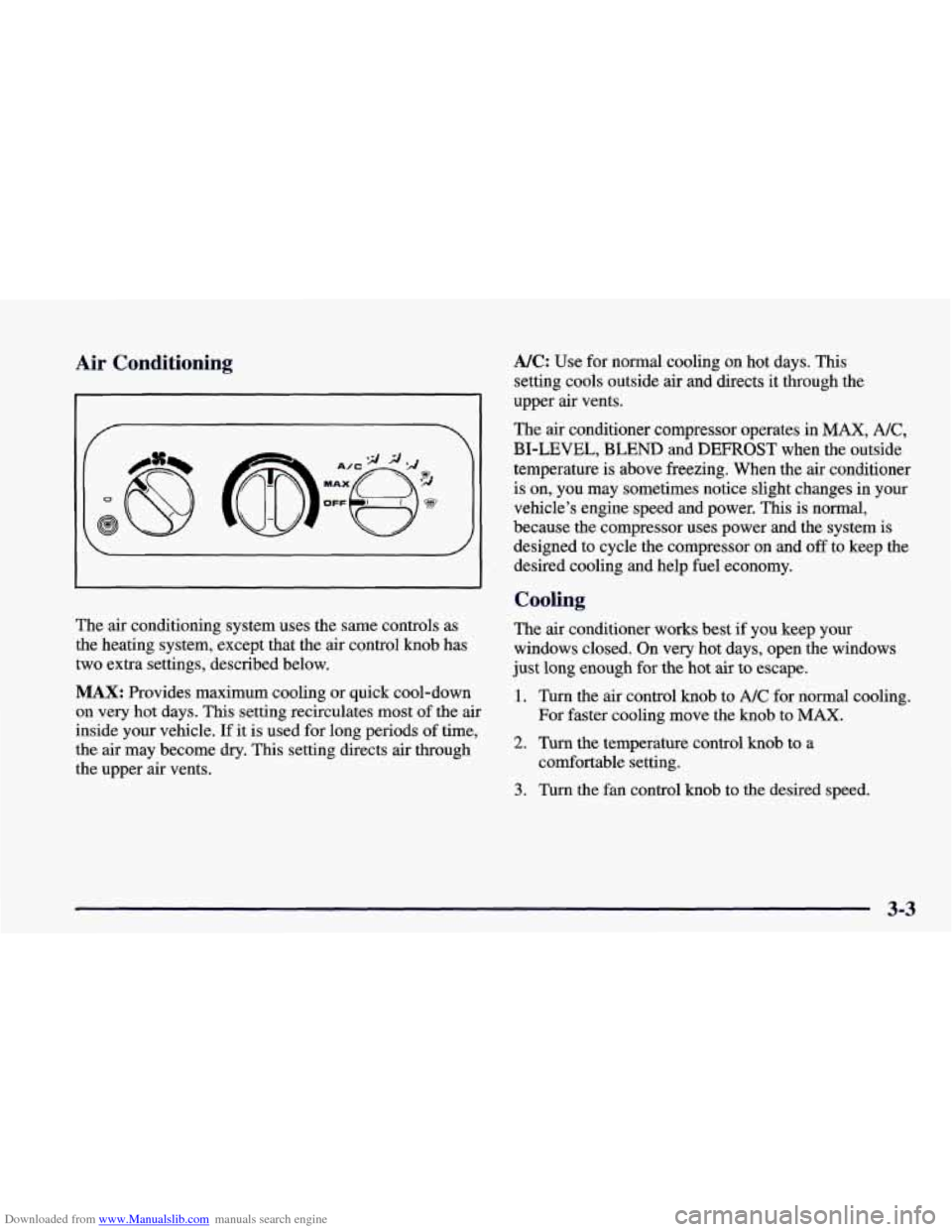
Downloaded from www.Manualslib.com manuals search engine Air Conditioning
The air conditioning system uses the same controls as
the heating system, except that the
air control knob has
two extra settings, described below.
MAX: Provides maximum cooling or quick cool-down
on
very hot days. This setting recirculates most of the air
inside your vehicle. If it is used for long periods of time,
the air may become
dry. This setting directs air through
the upper air vents.
A/C: Use for normal cooling on hot days. This
setting cools outside air and directs it through the
upper air vents.
The air conditioner compressor operates in
MAX, NC,
BI-LEVEL, BLEND and DEFROST when the outside
temperature is above freezing. When the air conditioner
is on, you may sometimes notice slight changes in your
vehicle’s engine speed and power. This is normal,
because the compressor uses power and the system
is
designed to cycle the compressor on and off to keep the
desired cooling and help fuel economy.
Cooling
The air conditioner works best if you keep your
windows closed. On very hot days, open the windows
just long enough for the hot
air to escape.
1. Turn the air control knob to A/C for normal cooling.
2. Turn the temperature control knob to a
3. Turn the fan control knob to the desired speed.
For
faster cooling move the knob to
MAX.
comfortable setting.
3-3
Page 208 of 402
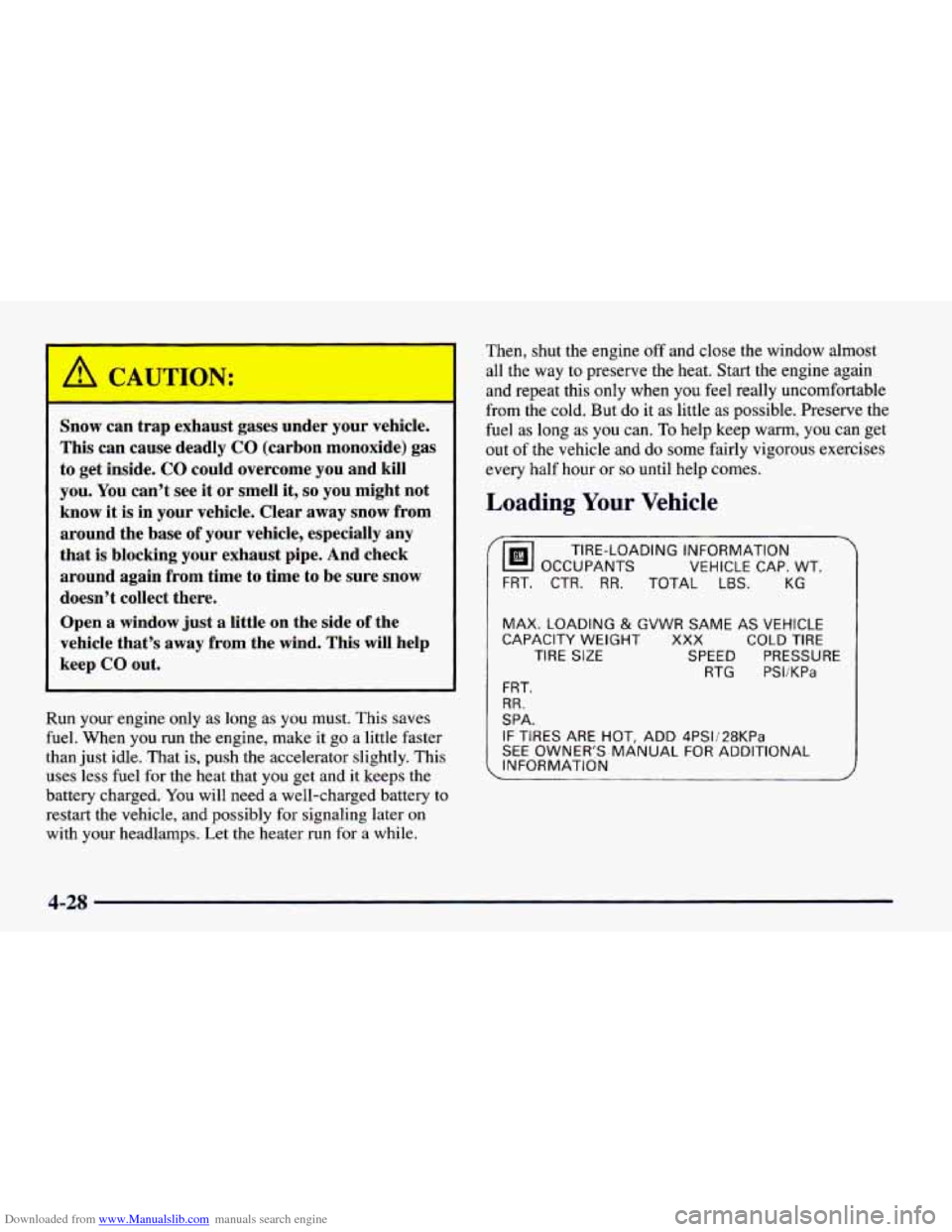
Downloaded from www.Manualslib.com manuals search engine a CAUTION:
Snow can trap exhaust gases under your vehicle.
This can cause deadly
CO (carbon monoxide) gas
to get inside. CO could overcome you and kill
you.
You can’t see it or smell it, so you might not
know it is in your vehicle. Clear away snow from
around the base of your vehicle, especially any
that
is blocking your exhaust pipe. And check
around again from time
to time to be sure snow
doesn’t collect there.
Open
a window just a little on the side of the
vehicle that’s away from the wind. This will help
keep
CO out.
Run your engine only as long as you must. This saves
fuel. When you run the engine, make it go a little faster
than just idle. That is, push the accelerator slightly. This
uses less fuel for the heat that
you get and it keeps the
battery charged.
You will need a well-charged battery to
restart the vehicle, and possibly for signaling later on
with your headlamps. Let the heater run for a while. Then,
shut the engine
off and close the window almost
all the way to preserve the heat. Start the engine again
and repeat this
only when you feel really uncomfortable
from the cold. But do it as little as possible. Preserve the
fuel as long as you can.
To help keep warm, you can get
out of the vehicle and do some fairly vigorous exercises
every half hour or
so until help comes.
Loading Your Ve’ kle
OCCUPANTS
VEHICLE CAP. WT.
.
TIRE-LOADING INFORMATION
FRT, CTR. RR. TOTAL LBS. KG
MAX. LOADING & GVWR SAME AS VEHICLE
CAPACITY WEIGHT XXX COLD TIRE
TIRE
SIZE SPEED PRESSURE
RTG PSPKPa
FRT.
RR.
SPA.
IF TIRES ARE HOT, ADD 4PSli28KPa
SEE OWNER’S MANUAL FOR ADDITIONAL
INFORMATION
4-28
Page 209 of 402
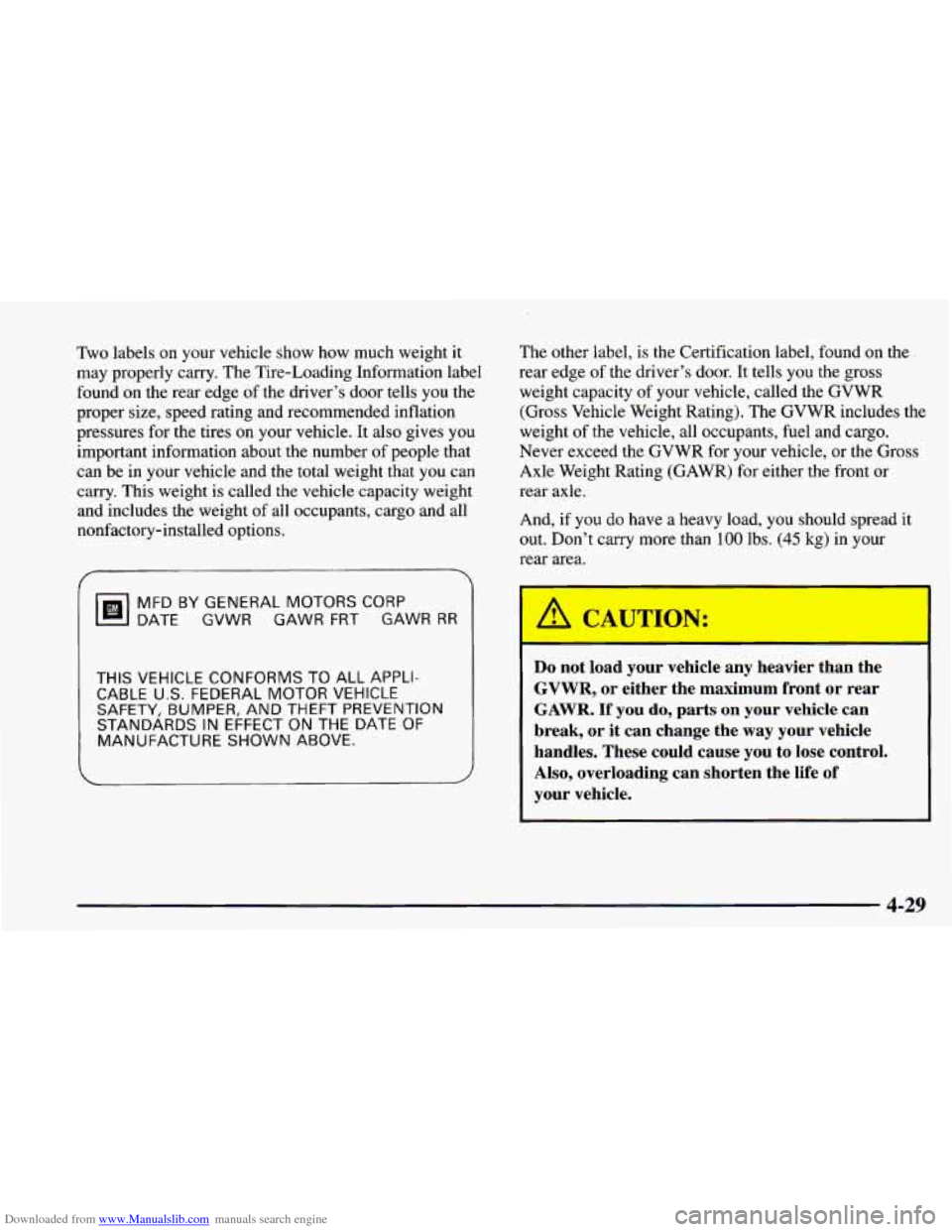
Downloaded from www.Manualslib.com manuals search engine Two labels on your vehicle show how much weight it
may properly carry. The Tire-Loading Information label
found on the rear edge
of the driver’s door tells you the
proper size, speed rating and recommended inflation
pressures for the tires on your vehicle. It also gives you
important information about the number of people that
can be in your vehicle and the total weight that you can
carry. This weight is called the vehicle capacity weight
and includes the weight
of all occupants, cargo and all
nonfactory-installed options.
MFD BY GENERAL MOTORS CORP
DATE GVWR GAWR FRT GAWR ~d
THIS VEHICLE CONFORMS TO ALL APPLI-
CABLE
U.S. FEDERAL MOTOR VEHICLE
SAFETY, BUMPER, AND THEFT PREVENTION
STANDARDS IN EFFECT ON THE DATE OF
MANUFACTURE SHOWN ABOVE.
The other label, is the Certification label, found on the
rear edge
of the driver’s door. It tells you the gross
weight capacity of your vehicle, called the GVWR
(Gross Vehicle Weight Rating).
The GVWR includes the
weight
of the vehicle, all occupants, fuel and cargo.
Never exceed the GVWR for your vehicle, or the Gross
Axle Weight Rating
(GAWR) for either the front or
rear axle.
And, if
you do have a heavy load, you should spread it
out. Don’t carry more than
100 lbs. (45 kg) in your
rear area.
I
Do not load your vehicle any heavier than the
GVWR, or either the maximum front or rear
GAWR. If you do, parts on your vehicle can
break, or it can change the way your vehicle
handles. These could cause you to lose control.
Also, overloading can shorten the life
of
your vehicle.
4-29
Page 211 of 402
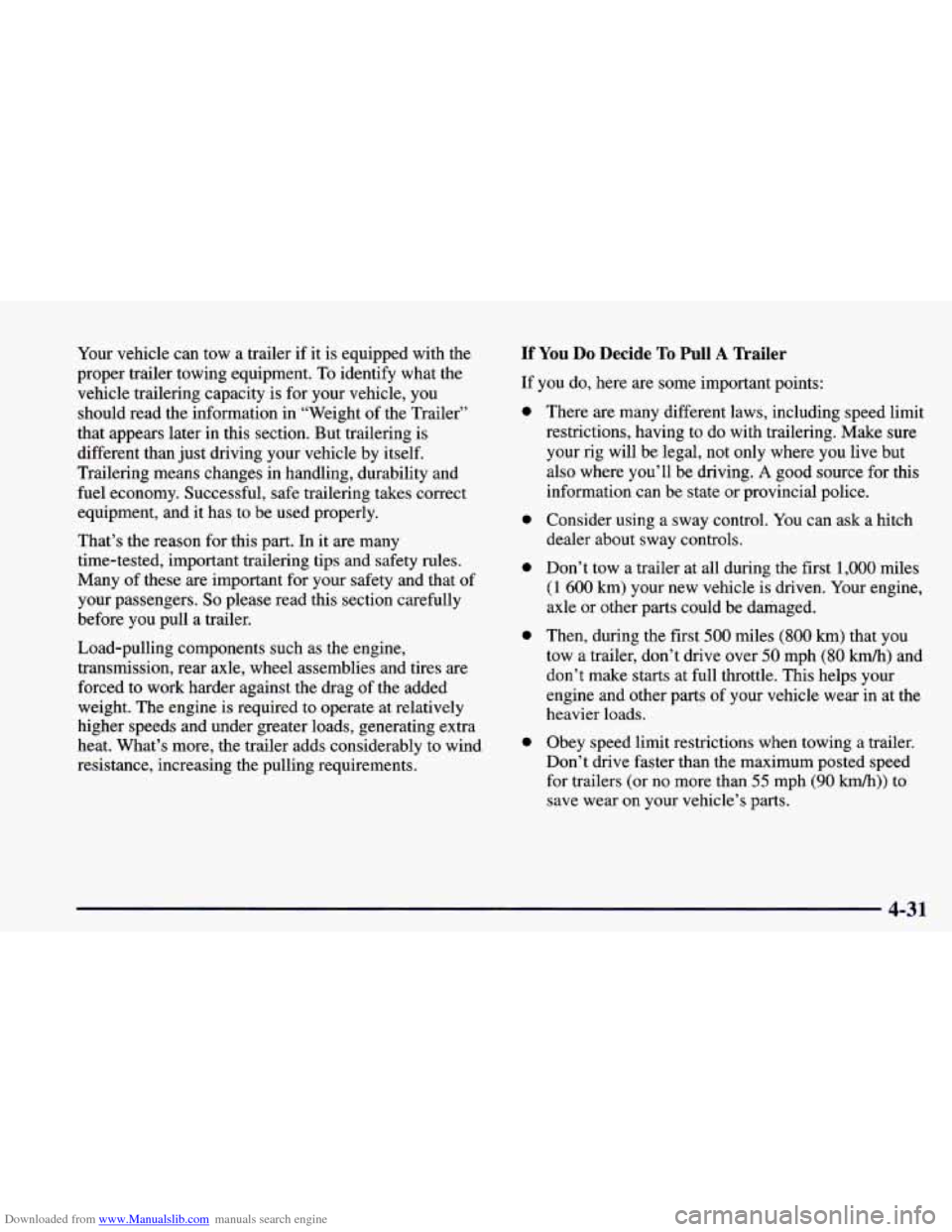
Downloaded from www.Manualslib.com manuals search engine Your vehicle can tow a trailer if it is equipped with the
proper trailer towing equipment.
To identify what the
vehicle trailering capacity is for your vehicle, you
should read the information in “Weight of the Trailer’’
that appears later in this section. But trailering is
different than just driving your vehicle by itself.
Trailering means changes in handling, durability and
fuel economy. Successful, safe trailering takes correct
equipment, and it has to be used properly.
That’s the reason for this part. In it are many
time-tested, important trailering tips and safety rules.
Many
of these are important for your safety and that of
your passengers.
So please read this section carefully
before you pull a trailer.
Load-pulling components such as the engine,
transmission, rear axle, wheel assemblies and tires are
forced to work harder against the drag of the added
weight. The engine is required to operate at relatively
higher speeds and under greater loads, generating extra
heat. What’s more, the trailer adds considerably to wind
resistance, increasing the pulling requirements.
If You Do Decide To Pull A Trailer
If you do, here are some important points:
a
a
a
0
0
There are many different laws, including speed limit
restrictions, having to
do with trailering. Make sure
your rig will be legal, not only where you live but
also where you’ll be driving.
A good source for this
information can be state or provincial police.
Consider using a sway control. You can ask a hitch
dealer about sway controls.
Don’t tow a trailer at all during the first
1,000 miles
(1 600 km) your new vehicle is driven. Your engine,
axle or other parts could be damaged.
Then, during the first
500 miles (800 km) that you
tow a trailer, don’t drive over
50 mph (80 km/h) and
don’t make starts at full throttle. This helps your
engine and other parts of your vehicle wear in at the
heavier loads.
Obey speed limit restrictions when towing a trailer.
Don’t drive faster than the maximum posted speed
for trailers (or no more than
55 mph (90 km/h)) to
save wear on your vehicle’s parts.
4-31
Page 259 of 402
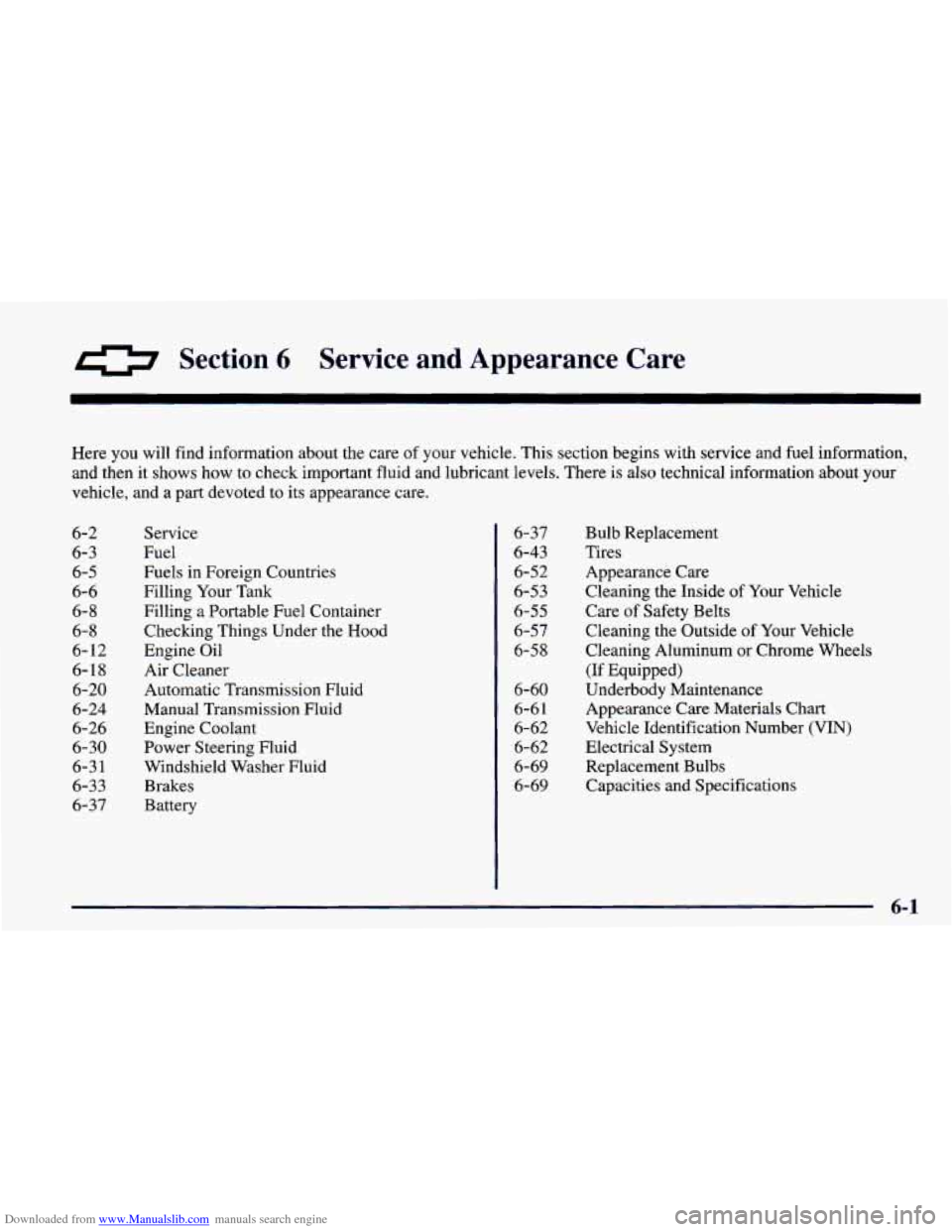
Downloaded from www.Manualslib.com manuals search engine Section 6 Service and Appearance Care
Here you will find information about the care of your vehicle. This section begins with service and fuel information,
and then it shows how to check important fluid and lubricant levels. There is also technical information about your
vehicle, and
a part devoted to its appearance care.
6-2
6-3 6-5
6-6 6-8
6-8
6- 12
6-18
6-20
6-24
6-26
6-30
6-3
1
6-33
6-37 Service
Fuel
Fuels in Foreign Countries
Filling Your Tank
Filling
a Portable Fuel Container
Checking Things Under the Hood
Engine Oil
Air Cleaner
Automatic Transmission Fluid
Manual Transmission Fluid
Engine Coolant
Power Steering Fluid
Windshield Washer Fluid
Brakes
Battery 6-37
6-43
6-52
6-53
6-55
6-57 6-5 8
6-60
6-6
1
6-62
6-62
6-69
6-69 Bulb Replacement
Tires
Appearance Care Cleaning the Inside
of Your Vehicle
Care of Safety Belts
Cleaning the Outside of Your Vehicle
Cleaning Aluminum or Chrome Wheels
(If Equipped)
Underbody Maintenance
Appearance Care Materials
Chart
Vehicle Identification Number (VIN)
Electrical System Replacement Bulbs
Capacities and Specifications
6-1
Page 264 of 402
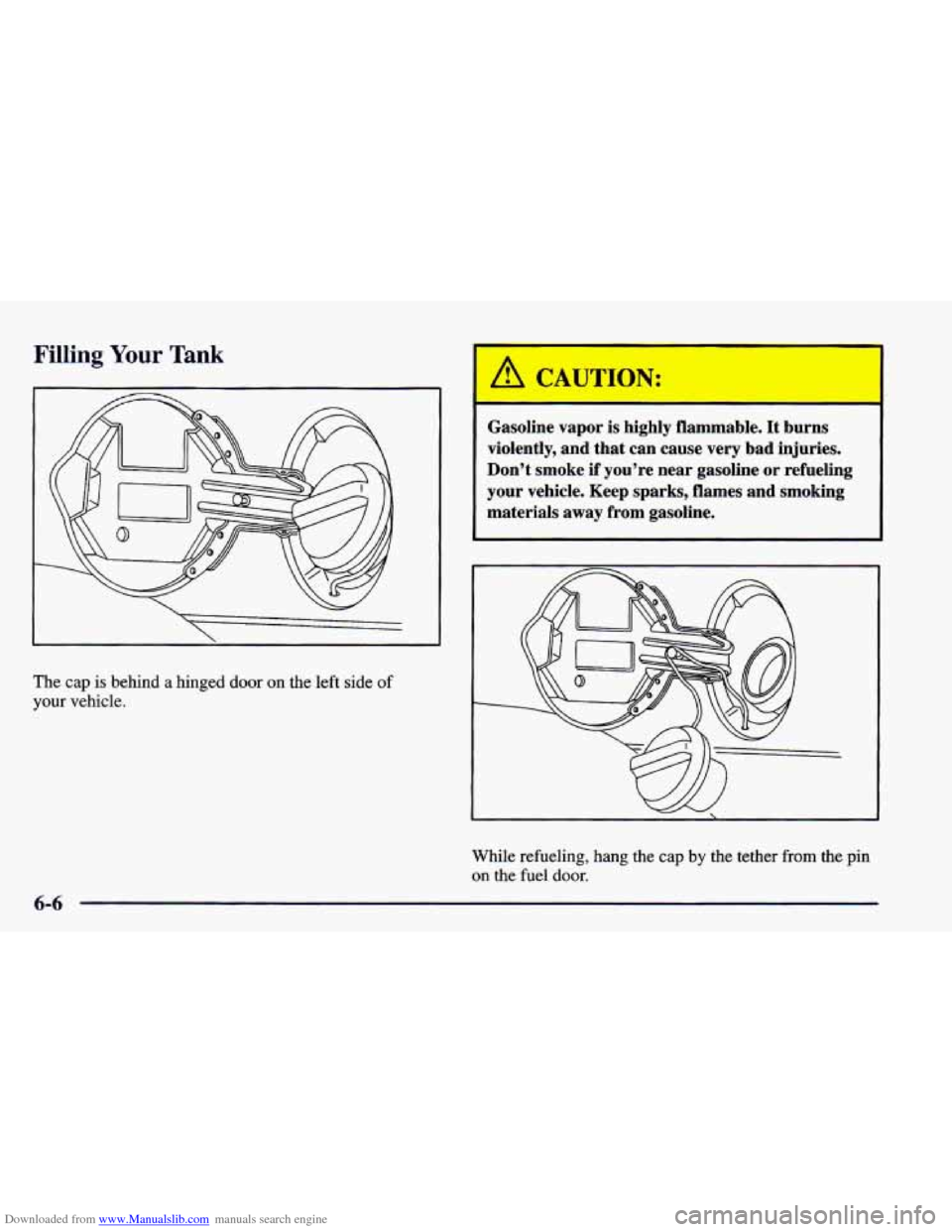
Downloaded from www.Manualslib.com manuals search engine Filling Your Tank
Gasoline vapor is highly flammable. It burns
violently, and that can cause very bad injuries.
Don’t smoke if you’re near gasoline or refueling
your vehicle. Keep sparks, flames and smoking
materials away from gasoline.
The cap is behind a hinged door on the left side of
your vehicle.
While refueling,
hang the cap by the tether from the pin
on the fuel door.
6-6
Page 265 of 402
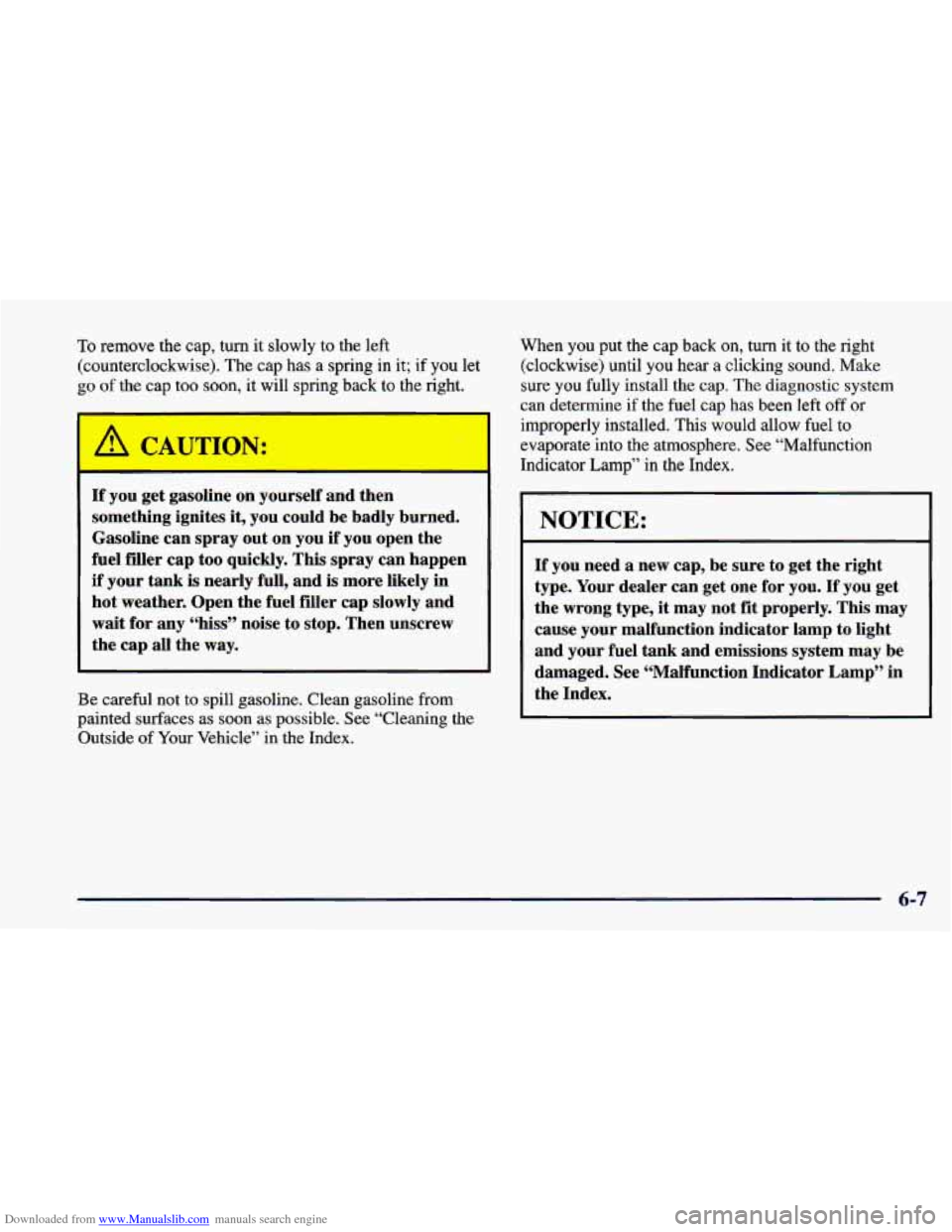
Downloaded from www.Manualslib.com manuals search engine To remove the cap, turn it slowly to the left
(counterclockwise). The cap has a spring in it;
if you let
go of the cap too soon, it will spring back to the right.
BN:
If you get gasoline on yourself and then
something ignites
it, you could be badly burned.
Gasoline can spray out on you if you open the
fuel filler cap too quickly. This spray can happen
if your
tank is nearly full, and is more likely in
hot weather. Open the fuel filler cap slowly and
wait for any “hiss” noise to stop. Then unscrew
the cap all the
way.
Be careful not to spill gasoline. Clean gasoline from
painted surfaces
as soon as possible. See “Cleaning the
Outside of Your Vehicle” in the Index. When you put
the cap
back on, turn it to the right
(clockwise) until you hear a clicking sound.
Make
sure you fully install the cap. The diagnostic system
can determine if the fuel cap has been left off
or
improperly installed. This would allow fuel to
evaporate into the atmosphere. See “Malfunction
Indicator Lamp” in the Index.
NOTICE:
If you need a new cap, be sure to get the right
type. Your dealer can get one for
you. If you get
the wrong type,
it may not fit properly. This may
cause your malfunction indicator lamp to light
and your fuel tank and emissions system may be
damaged. See “Malfunction Indicator Lamp” in
the Index.
6-7
Page 270 of 402
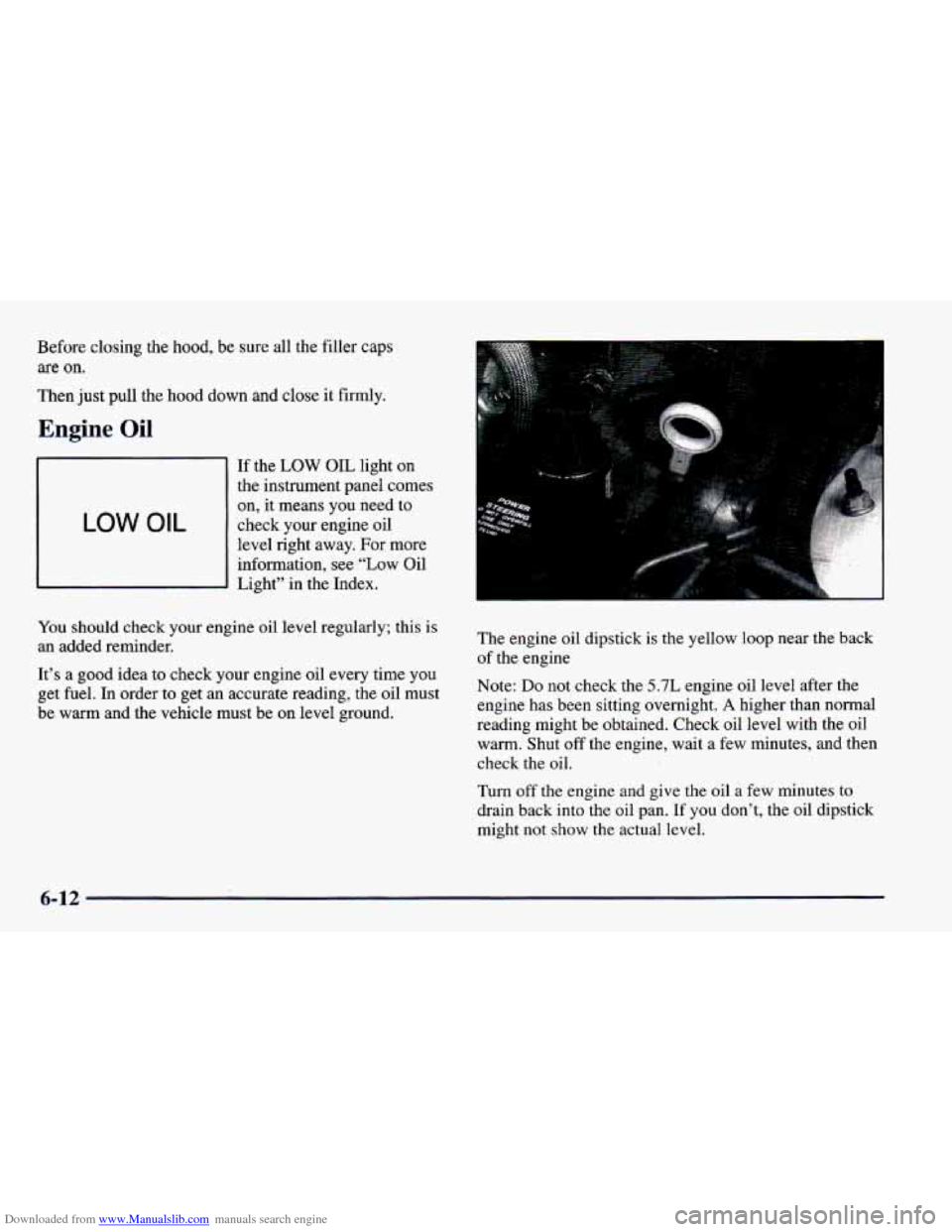
Downloaded from www.Manualslib.com manuals search engine Before closing the hood, be sure all the filler caps
are on.
Then just pull the hood down and close it firmly.
Engine Oil
LOW OIL
If the LOW OIL light on
the instrument panel comes
on, it means you need to
check your engine oil
level right
away. For more
information, see “Low Oil
Light”
in the Index.
You
should check your engine oil level regularly; this is
an added reminder.
It’s a good idea to check your engine oil every time you
get
fuel. In order to get an accurate reading, the oil must
be warm and the vehicle must be on level ground. The
engine oil dipstick is the yellow loop near the back
of the engine
Note: Do not check the 5.7L engine oil level after the
engine has been sitting overnight,
A higher than normal
reading might be obtained. Check oil level with the oil
warm. Shut off the engine, wait a few minutes, and then
check the oil.
Turn off the engine and give the oil a few minutes to
drain back into the oil pan.
If you don’t, the oil dipstick
might not show the actual level.
6-12